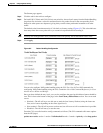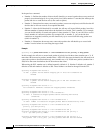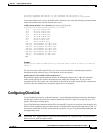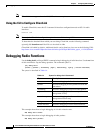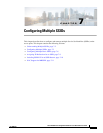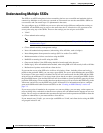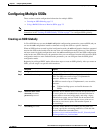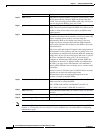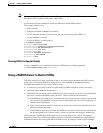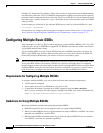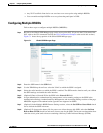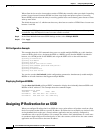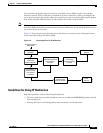
7-3
Cisco IOS Software Configuration Guide for Cisco Aironet Access Points
OL-30644-01
Chapter 7 Configuring Multiple SSIDs
Configuring Multiple SSIDs
Configuring Multiple SSIDs
These sections contain configuration information for multiple SSIDs:
• Creating an SSID Globally, page 7-3
• Using a RADIUS Server to Restrict SSIDs, page 7-5
Note You need to configure SSIDs globally and then apply them to a specific radio interface. Follow the
instructions in the “Creating an SSID Globally” section on page 7-3 to configure SSIDs globally.
Creating an SSID Globally
In Cisco IOS Releases you use the dot11 ssid global configuration command to create an SSID, and you
can use the ssid configuration interface command to assign the SSID to a specific interface.
When an SSID has been created in global configuration mode, the ssid configuration interface command
attaches the SSID to the interface but does not enter ssid configuration mode. However, if the SSID has
not been created in global configuration mode, the ssid command puts the CLI into SSID configuration
mode for the new SSID. However, the parameters that you can configure from the radio interface SSID
configuration mode are more limited than the parameters you can configure from the SSID global
configuration mode.
Beginning in privileged EXEC mode, follow these steps to create an SSID globally. After you create an
SSID, you can assign it to specific radio interfaces.
Command Purpose
Step 1
configure terminal Enter global configuration mode.
Step 2
dot11 ssid ssid-string Create an SSID and enter SSID configuration mode for the new
SSID. The SSID can consist of up to 32 alphanumeric
characters. SSIDs are case sensitive.
The SSID can consist of up to 32 alphanumeric, case-sensitive,
characters.
Note TAB and trailing spaces are invalid characters for
SSIDs.
Step 3
authentication client
username username
password password
(Optional) Set an authentication username and password that
the access point uses to authenticate to the network when in
repeater mode or non-root bridge mode, and using a legacy
authentication system, such as LEAP. Set the username and
password on the SSID that the repeater access point uses to
associate to a root access point, with another repeater or
non-root bridge.
Step 4
accounting list-name (Optional) Enable RADIUS accounting for this SSID. For
list-name, specify the accounting method list. Click this link
for more information on method lists:
http://www.cisco.com/c/en/us/td/docs/ios/12_2/security/confi
guration/guide/fsecur_c/scfacct.html



